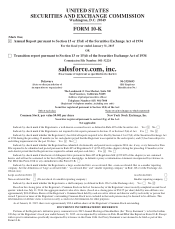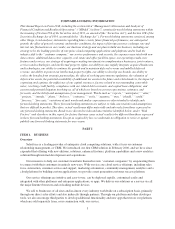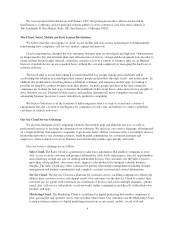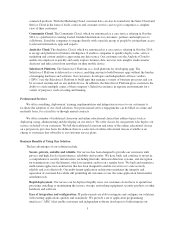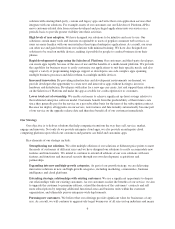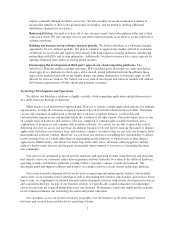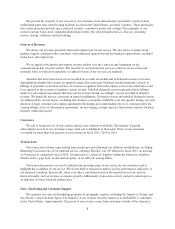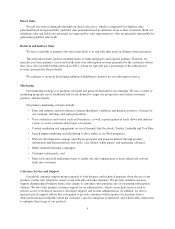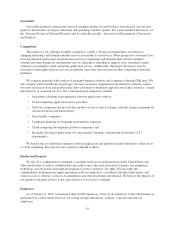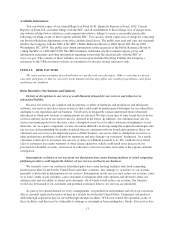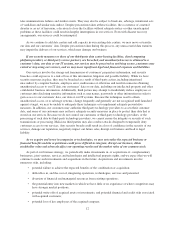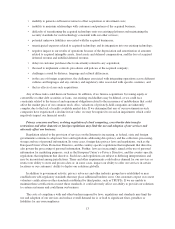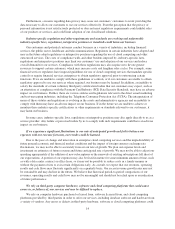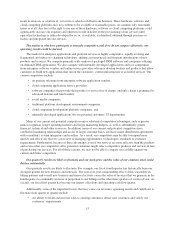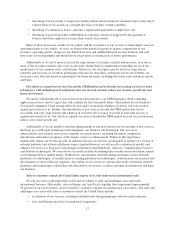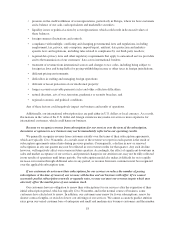Salesforce.com 2015 Annual Report Download - page 14
Download and view the complete annual report
Please find page 14 of the 2015 Salesforce.com annual report below. You can navigate through the pages in the report by either clicking on the pages listed below, or by using the keyword search tool below to find specific information within the annual report.We provide the majority of our services to our customers from infrastructure operated by us but secured
within third-party data center hosting facilities located in the United States and other countries. These third-party
data center providers provide space, physical security, continuous power and cooling. The remainder of our
services operate from cloud computing platform providers who offer Infrastructure as a Service, including
servers, storage, databases and networking.
Sources of Revenue
We derive our revenues primarily from subscription fees for our service. We also derive revenues from
premier support, which provides customers with additional support beyond the standard support that is included
in the basic subscription fee.
We recognize subscription and support revenue ratably over the contract term, beginning on the
commencement date of each contract. The majority of our professional services contracts are on a time and
materials basis, for which we generally recognize revenue as the services are rendered.
Amounts that have been invoiced are recorded in accounts receivable and in deferred revenue or revenue,
depending on whether the revenue recognition criteria have been met. Deferred revenue primarily consists of
billings or payments received in advance of revenue recognition from subscription services described above and
is recognized as the revenue recognition criteria are met. Unbilled deferred revenue represents future billings
under our subscription agreements that have not been invoiced and, accordingly, are not recorded in deferred
revenue. We generally invoice customers in annual installments. Deferred revenue and unbilled deferred revenue
are influenced by several factors, including new business seasonality within the year, the specific timing, size and
duration of large customer subscription agreements, the timing and compounding effects of customer renewals,
varying billing cycles of subscription agreements, invoice timing, foreign currency fluctuations and new business
linearity within the quarter.
Customers
We sell to businesses of all sizes and in almost every industry worldwide. The number of paying
subscriptions at each of our customers ranges from one to hundreds of thousands. None of our customers
accounted for more than five percent of our revenues in fiscal 2015, 2014 or 2013.
Transactions
Our transaction volume, representing transactions processed through our solutions and platform, excluding
Marketing Cloud and one of our platform service offerings, Heroku, was 585 billion for fiscal 2015, an increase
of 59 percent as compared to fiscal 2014. A transaction is a retrieval or update within the Salesforce database,
which can be a page load, an information query, or an API call, among others.
Our transaction metrics are used to illustrate the growing usage of our service by our customers and to
highlight the scalability of our service. We do not believe transaction metrics are key performance indicators of
our financial condition. Specifically, there is no direct correlation between the transaction activity and our
financial results, such as revenue or expense growth. Additionally, transaction activity cannot be relied upon as
an indicator of future financial performance.
Sales, Marketing and Customer Support
We organize our sales and marketing programs by geographic regions, including the Americas, Europe and
Asia Pacific, which includes Japan. The majority of our revenue from the Americas is attributable to customers
in the United States. Approximately 28 percent of our revenue comes from customers outside of the Americas.
8





